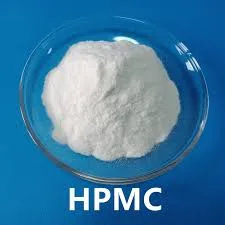
юли . 24, 2024 01:56 Back to list
Investigation of HPMC Solubility Characteristics in Ethanol for Pharmaceutical Applications and Formulation Development
Solubility of HPMC in Ethanol An Overview
Hydroxypropyl methylcellulose (HPMC) is a widely used cellulose ether that has found applications in various fields, including pharmaceuticals, food, and construction. One of the critical parameters to consider in the utilization of HPMC is its solubility in different solvents, which greatly influences its functionality and application. Among potential solvents, ethanol (ethyl alcohol)—a common organic solvent—plays a significant role due to its efficacy in dissolving many polar and non-polar substances.
Understanding HPMC
HPMC is a semi-synthetic polymer derived from cellulose. It's modified to enhance its properties and solubility in a variety of environments. The chemical structure of HPMC includes hydroxypropyl and methyl functional groups, which bestow it with unique characteristics such as film-forming ability, thickening, and gelling properties. Due to these features, HPMC is extensively used in pharmaceutical formulations for tablet coatings, controlled-release applications, and as a stabilizer in suspensions.
Solubility Characteristics of HPMC
The solubility of HPMC is influenced by several factors, including its molecular weight, degree of substitution, and the nature of the solvent. In general, HPMC is known to be soluble in water and various polar solvents. However, its solubility in ethanol can present unique challenges and opportunities
1. Molecular Weight Dependency The solubility of HPMC in ethanol is inversely proportional to its molecular weight. Lower molecular weight HPMC tends to dissolve more readily in ethanol, while higher molecular weight variants may exhibit reduced solubility. This property can be strategically used in formulations where the desired viscosity or gel strength requires a specific type of HPMC.
2. Ethanol Concentration The concentration of ethanol plays a crucial role in HPMC solubility. Pure ethanol is generally considered a poor solvent for HPMC, leading to incomplete dissolution. However, mixtures of ethanol and water can enhance solubility. Typically, a mixture with a ratio of 6040 (ethanol to water) has been shown to optimize the solubility of HPMC, achieving a balance between solvent interaction and dissolution efficiency.
hpmc solubility in ethanol

3. Temperature Influence Like many solutes, the solubility of HPMC in ethanol also increases with temperature. Heating the ethanol solution can promote better solubilization of HPMC, making it a practical approach for achieving desired concentrations in laboratory and industrial settings.
Applications of HPMC in Ethanol Solutions
Knowing the solubility behavior of HPMC in ethanol is invaluable for its applications
- Pharmaceutical Formulations HPMC dissolved in ethanol can be used for preparing various dosage forms, particularly in controlled-release preparations where a specific dissolution profile is needed.
- Food Industry In the food industry, HPMC solutions in ethanol can serve as stabilizers or thickening agents, contributing to the texture and consistency of products.
- Cosmetic Products HPMC’s thickening and film-forming properties are exploited in many cosmetic formulations, where ethanol acts as a solvent for active ingredients.
Conclusion
The solubility of Hydroxypropyl Methylcellulose (HPMC) in ethanol is a significant consideration for its various applications across multiple industries. Its solubility is affected by factors such as molecular weight and the composition of the solvent mixture, highlighting the need for a thoughtful approach to formulation development. By understanding these parameters, chemists and formulators can effectively harness the unique properties of HPMC in their products, leading to enhanced performance and consumer satisfaction.
-
Unlocking the Benefits of HPMC Products: A Gateway to Versatile Applications
NewsAug.07,2025
-
Unleashing the Potential of HPMC Ashland: A Comprehensive Look
NewsAug.07,2025
-
Tile Bonding Cellulose: The Key to Superior Adhesion and Durability
NewsAug.07,2025
-
Hydroxypropyl Methylcellulose Powder: The Versatile Component in Modern Pharmaceuticals
NewsAug.07,2025
-
Hydroxyethyl Cellulose: The Versatile Solution for Various Industries
NewsAug.07,2025
-
Hydroxyethyl Cellulose (HEC): The Versatile Polymer for Various Applications
NewsAug.07,2025







